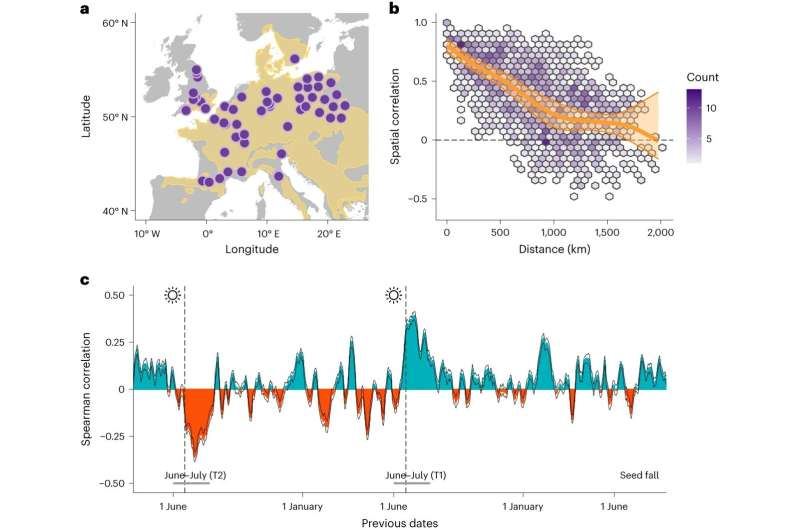This article has been reviewed according to Science X's editorial process and policies. Editors have highlighted the following attributes while ensuring the content's credibility:
fact-checked
trusted source
proofread
Summer solstice found to trigger synchronized beech tree reproduction across Europe

A new study published in Nature Plants has found that the summer solstice acts as a "starting gun" to synchronize beech tree reproduction across vast distances in Europe, affecting ecosystem functions.
An international research team from the University of Liverpool, the University in Poznań, Poland, and the University of Canterbury, Christchurch, in New Zealand, joined forces to look at the associations between weather patterns and seed production in perennial plants like the European beech (Fagus sylvatica), and to explore how tree reproduction is consistently synchronized across vast distances.
Previous work by the team showed that the key to achieving this synchrony is a coordinated response to an external trigger, such as weather, but how the European beech—which grows across the European continent with greatly varying climates—achieved this was a mystery.
The research team looked at fine-scale changes in plant responses to temperature and found that the 21st of June—the summer solstice and the longest day of the year—acted as a celestial cue, triggering synchronized responses to weather conditions among widely separated populations of European beech.
Dr. Valentin Journé, a postdoctoral researcher at Adam Mickiewcz University in Poznań, Poland, who led the analysis, said, "We got inspired by a recent Science paper where researchers from Switzerland found that the effects of temperature on leaf senescence switch at the summer solstice. The summer solstice is the longest day of the year and happens at the same time anywhere in the Hemisphere."
Jessie Foest, a Ph.D. researcher from the University of Liverpool who was involved in the research, said, "The sharp response of beech trees is just remarkable. Once the day starts to shorten after the summer solstice, the temperature sensing window opens simultaneously, all across Europe."
"What's truly jaw-dropping is that the change in day length that the trees are able to detect is really small—we are talking about a few minutes over a week. Apparently, trees are able to recognize the difference."
Many perennial plants do not reproduce regularly and forgo reproduction for a few years to accumulate resources and then produce a bumper seed crop. The remarkable synchrony of this interannual variation was known to extend to hundreds and thousands of kilometers in many species. This study reveals how plants can achieve coordination over such great distances.
Such large-scale regional synchronization of seed production by trees has important consequences for ecosystems. Large-seeding years result in a pulse of resources for wildlife, while reproductive failures result in famines for seed-eating animals. When this variation is synchronized at sub-continental scales the consequences include far-reaching disruptions in food webs, including rodent outbreaks, migration of ungulates and birds, and spikes in wildlife-borne human diseases.
More information: Valentin Journé et al, Summer solstice orchestrates the subcontinental-scale synchrony of mast seeding, Nature Plants (2024). DOI: 10.1038/s41477-024-01651-w
Provided by University of Liverpool




















